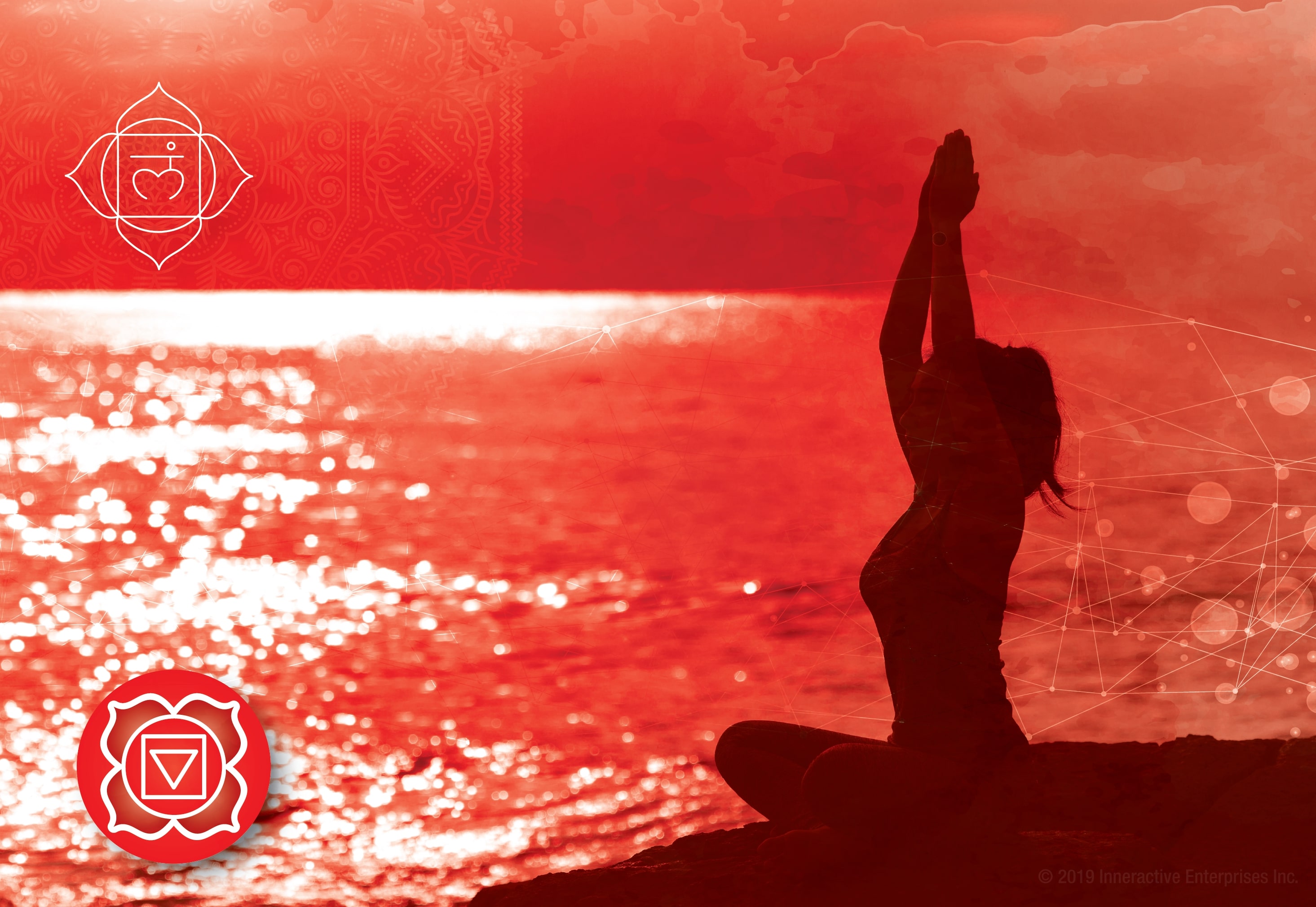Muladhara Chakra: A Guide to Understanding The Root Chakra
There are believed to be seven different focal points of energy throughout the body. They are called chakras. Some people believe that these points are associated with everything habits, behaviors, personalities, and even feeling a certain way. The very first chakra is called the root chakra.
This article is based on people’s beliefs in metaphysics.
What Does The Root Chakra Mean?
The root chakra is also called the Muladhara in Sanskrit. According to Hindu tradition, it is the center of our emotional being—this is why it is the first chakra. In Sanskrit, Muladhara means “foundation,” further underscoring how central the root chakra is. It is often depicted with an inverted triangle and a red lotus flower.

The root chakra is the seat of our balance and groundedness.
This root chakra is believed to be a guiding force in our lives. Some people think it can support us through the ups and downs of life and help us maintain a sense of balance and being grounded. As such, this chakra is believed to be located at the base of the spine, symbolizing our connection to the earth and the root of our energy flow.
The first chakra lays the foundation for understanding the entirety of the chakra system, and as such it is important to grasp how it fits into the whole.
In short, chakras are believed to be energy points that are connected to an individual’s health. They may be affected by physical symptoms manifested by the individual, so it is important to balance them in order to center oneself and find wellbeing. Each chakra is also associated with a color.

The root chakra is the first chakra, at the bottom of the lineup.
In order, the chakras are as follows:
- Red: Root/Muladhara chakra
- Orange: Sacral/Svadhisthana chakra
- Yellow: Solar Plexus/Manipura chakra
- Green: Heart/Anahata chakra
- Blue: Throat/Vishudda chakra
- Indigo: Third Eye/Anja charka
- Purple: Crown/Sahaswara chakra
Within this system, the root chakra is considered by some people to have a centering effect. It is symbolically connected to a person’s sense of security, stability, and their place in the world. This chakra may be affected by whether or not you feel comfortable and secure in your world. Basic needs, such as water, food, shelter, and fiscal comfort may impact this chakra. If a person does not feel secure in these aspects, their root chakra may be affected.
The people who surround us in our lives can also impact the balance of this chakra. The root chakra may be affected by a person’s social standing and whether they feel comfortable with the people around them. Since we often define ourselves by our relationships to other people, this is another aspect of the Muladhara chakra that should not be overlooked. In addition to chakras, a person’s energy may also be manifested in the form of an aura.
Feeling safe and balanced may help create a healthy root chakra. By being more comfortable and settled within our daily needs, you may feel more connected with the chakra system as a whole.
Problems With The Root Chakra

Many people’s chakra balancing routines involve spending time in nature.
Instability in your life, such as the loss of a job, home, or the end of an important relationship, may cause issues to arise with the root chakra. However, this chakra is also believed to be shaped by early childhood experiences and traumas. If you felt insecure as a child, you may still have some of those feelings of instabiltiy as an adult. Working with these emotions and overcoming past traumas may help to heal this chakra.
Root Chakras That Are Blocked or Imbalanced
The chakra system functions on a holistic level, meaning that issues with one chakra may trickle over and affect the other energy points in the system. If a chakra is blocked or under-performing, the other chakras in the body may overcompensate and try to function for the blocked chakra, leading to an imbalance in the entire system. Finding a chakra balancing routine that works for you may help you to find wellness within spiritual traditions.
Some things that can affect the balance of chakras include fear, big life changes, anxiety about the future, and conflict with others.
Symptoms of an Imbalance in The Root Chakra
There are several signs of an imbalance with the root chakra. These include feelings of uneasiness, not feeling centered in your life, or a general sense of insecurity.
Some people believe that chakra imbalances can manifest as either a blockage or a chakra that is overperforming and trying to compensate for another chakra. Excessive energy, restlessness, irritation, and general agitation may suggest the root chakra is overcompensating. Luckily, there are many chakra healing techniques that may prove effective over time, if you are patient and consistent in utilizing them.
How to Heal The Root Chakra
While an imbalanced or blocked chakra may be annoying to deal with, experts in spiritual healing believe there are several strategies you can try to fix this problem.
Since the root chakra is the basis of the entire chakra system, having a thorough understanding of its function within the seven energy points is crucial. Try being more mindful of what your body needs, and listen to what it tells you. Find little things that help ground you during big changes in your life or times of instability.
Using The Outdoors to Balance Your Root Chakra
The root chakra is the base chakra. It is a symbolic representation of our primal connection to the earth and our need to survive. As such, some people think that doing activities outdoors and finding ways to reconnect with nature may be effective in balancing this chakra. The method could be as simple as doing activities outside or even taking a walk in the sunshine.
One of the most popular methods for this includes planting a garden. Getting your hands dirty and fostering the growth of living things is an affirming way to reconnect with mother nature and find balance. Other methods may include camping or taking a hike. These activities are enjoyable anytime, but they are especially beneficial in finding perspective on your place in the world and connecting with nature on a deeper level.
Additionally, some people like to try yoga outside. Since it’s already a spiritual practice, you can only benefit from the added immersion in nature and the outdoors as you center yourself in the present moment. Finally, try meditating and sitting in silence (with all cellphones and other technology far away). Find solace in the stillness, and remember that you came from the earth and it is where you belong.
Using Foods to Balance Your Root Chakra

Red foods may help balance and heal the root chakra.
It’s well known that health and nutrition go hand in hand. But not as many people realize that there may be a connection between what you eat and how you balance your chakra system. In particular, it is believed that root vegetables, foods with lots of protein, and red foods in general can help you balance the root chakra.
The following are some foods you may want to try to help balance your root chakra:
- Red potatoes
- Broth
- Carrots
- Ginger
- Grains
- Red apples
- Tomatoes
- Radishes
Using Exercise to Balance Your Chakra
Exercise is beneficial in all its forms, and some people think it can even help clear your mind and balance your chakras.
Yoga is one of the most popular exercises for balancing your chakra, as it connects the movements of the body with the breath, finding a rhythm and flow throughout the session.
You can also try dancing to balance your chakras. It is an expressive exercise that encourages emotion and creativity.
Finally, try hitting the jogging track. Running and walking outdoors has proven health benefits, and can reduce blood pressure.
Meditation For The Root Chakra
Breathe in. Breathe out. Let all your stress melt away during a mindful meditation session. By focusing on yourself and your energy, you may be able to feel more balanced after taking the time to meditate.
Meditation doesn’t have to mean sitting in silence for hours. It can also involve sounds, healing crystals, and aromatherapy.
Aromas can be added by applying essential oils or diffusing them in the room. In particular, angelica root, cedarwood and patchouli are thought to be effective for the root chakra.
The syllable “lam” can be chanted or listened to on repeat to feel grounded.
Finally, use red stones to tap into the red energy of the chakra. Bloodstone and jasper held or placed over your root chakra may help you meditate.
This type of meditation doesn’t just benefit the root chakra—it can also assist in balancing the entire chakra system and awakening a higher sense of spirituality.
Affirmations For The Root Chakra
Everyone wants to be affirmed, and it turns out that chakras do, too. Daily affirmations may help you to feel more calm and centered throughout the day, and certain phrases may connect to specific chakras in a healing, affirming way.
If you’d like to try affirming yourself for your root chakra, try some of the following phrases:
- I am safe and secure
- I am connected to the earth
- I have enough
- I am in control of my decisions
- I am at peace
- I am supported
- My needs are met
The primal nature of the root chakra means some people associate it with human sexuality. This can manifest as a deeper trust and connection with your partner. Affirmations that may contribute to deeper intimacy are as follows:
- I am confident with my partner
- I am safe with my partner
- I trust my partner
It’s likely that many people could experience an imbalance in the root chakra at some point, as it is affected by our basic needs. A new job, moving to a new place, having a tight budget, and meeting a new partner could all impact this primal chakra. As inevitable parts of life, it’s important to understand how this chakra functions and have the right tools and remedies on hand for when you do start to feel imbalanced in your life.
By tending to your root chakra, you may feel more secure and connected to those around you. It could help you feel confident in making a big decision or starting a new chapter in your life. There are several ways to know if your root chakra is healthy, including:
- A desire to connect with the people around you
- Healthy eating and exercise habits
- A sense of stability and security
- Less reliance on material objects for comfort
- Clear thinking
This chakra can ground us and provide many benefits, if only we tend to it and learn to find comfort with ourselves and the world around us.
